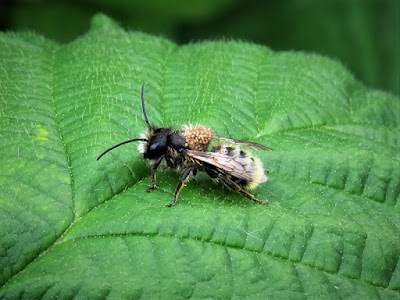Something of interest can be found throughout the year though perhaps it is best in winter when the ponds throng with wildfowl. There are a few seats. It is the type of place to sit and watch just as much as it is poking around looking for things. During this visit two fly-bys by a singing Cuckoo was the reward.
The flat landscape and its open position means it is not a place to visit on a windy day. It also means that getting close to wildlife other than the Canada Geese and Mallard that come to be fed is not easy.
Here are a few images:
The only vaguely obliging bird of interest was this Sedge Warbler belting his song from one of last year's Bulrushes (Typha latifolia). I would have trouble identifying the bird as a Sedge Warbler and the normally very distinct creamy eyebrow is almost absent on this bird. Bulrush has many other colloquial names, including Reedmace and Cattail.
A mining bee (Andrena sp.). Identification is never easy in this group and made harder here by the thorax being apparently covered in mites. There are many parasites of mining bees though the literature indicates that most attack the bees or their larvae in the nest and do not attach themselves to the adults. These see likely to be non-parasitic mites that have been living harmlessly in the bee's nest and are now hitching a lift to disperse.
This seems to be one of the Cephidae or stem-boring sawflies. The only example on Steven Falk's Flickr gallery that shows a thin yellow collar is the Willow Twig Borer (Janus luteipes).
This Common Nettle-tap moth (Anthophila fabriciana) is preferring a dandelion (Taraxacum sp.) to the abundant Common or Stinging Nettles (Urtica dioica). Lurking in amongst the flower petals and just about identifiable are two...
...Cocksfoot Moths (Glyphipterix simpliciella), this one on a buttercup (Ranunculus sp.)
A tiny and delicate cranefly (or similar) on a buttercup.
If there are nettles around then there will be Nettle Weevils (Phyllobius pomaceus).
A larva of a 7 Spot Ladybird (Coccinella 7-punctata)
Stunning looking beetles mating. I think Chrysolina fastuosa (they really ought to have a vernacular name since they are so spectacular).
Note
More on Doxey Marshes and its location Here.
(Ed Wilson)








